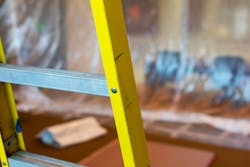You're a supervisor, and your crew is on a job where they need two 12-foot ladders, but all you have are two 10-foot ladders. Bill says he can step up beyond the red line on his ladder. In fact, he says he does it all the time. Jim says he can stack wooden pallets under his ladder to get the necessary height. You're not comfortable with either solution, but it's a long way back to the shop. It's only a couple of feet, so no big deal right?. Bill also suggests that you can make "crash pads" out of some empty cardboard boxes in case anyone falls.
When you attempt to set up your ladder outside at a new client’s site, you discover the work will take place over a bed of loose gravel. You can’t get your ladder to stay put on top of that surface. You tell your client you have to dig down to the dirt below the gravel, and he says you will not be allowed to do that. What should you do in these and similar cases?
OSHA citation statistics show that many companies face similar conundrums and choose to violate ladder safety rules. Usually, it's "just this once" repeatedly — and that attitude generates multiple violations. Worse, it generates multiple injury incidents, some of which may be career-ending or even life-ending.
There are some solutions to “insufficient ladder syndrome.” First, properly scope out the job. Today, nearly everyone has a smart phone, so it’s possible to see the job site (via Skpe, for example) without traveling there. Identify the potential safety problems, and figure out a solution for each one.
In the case of the gravel, you asked about digging. In response to the negative on that, you could have asked if they can provide a 4x8 sheet of plywood or something that will keep it from sliding.
In general, companies purchase ladders based on cost rather than probably use. You might need a 6-foot stepladder in 10% of jobs and a 10-foot ladder in 30% of jobs, but if all of those jobs have sufficient space for a 10-foot ladder then you are better off buying all 10-foot ladders than any 6-foot ladders. Now if someone takes a 10-foot ladder on a 6-foot ladder job, you aren’t short a 10-foot ladder because you effectively have an extra one.
A solution that works well is to avoid buying stepladders at all. Instead, buy folding fiberglass ladders. Yes, these are quite expensive. But their versatility means you eliminate ladder games that would otherwise be unavoidable — and you eliminate a few hundred “reasons” for bad ladder safety behavior. This type of ladder is both an extension ladder and an adjustable stepladder. In most stepladder positions, it is more stable than a regular stepladder. A service truck equipped with a couple of these will not have to be equipped with two extension ladders and two to four stepladders, so take that into your cost considerations.
If your company has a pattern of making exceptions to ladder safety rules “just this once,” there is always a solution that foresight and preparation will provide. When someone wants to use the “just this once” justification, remind them that it could easily mean falling and breaking your neck “just this once.” Foresight and preparation make you safe not “just this once” but always.
About the Author

Mark Lamendola
Mark is an expert in maintenance management, having racked up an impressive track record during his time working in the field. He also has extensive knowledge of, and practical expertise with, the National Electrical Code (NEC). Through his consulting business, he provides articles and training materials on electrical topics, specializing in making difficult subjects easy to understand and focusing on the practical aspects of electrical work.
Prior to starting his own business, Mark served as the Technical Editor on EC&M for six years, worked three years in nuclear maintenance, six years as a contract project engineer/project manager, three years as a systems engineer, and three years in plant maintenance management.
Mark earned an AAS degree from Rock Valley College, a BSEET from Columbia Pacific University, and an MBA from Lake Erie College. He’s also completed several related certifications over the years and even was formerly licensed as a Master Electrician. He is a Senior Member of the IEEE and past Chairman of the Kansas City Chapters of both the IEEE and the IEEE Computer Society. Mark also served as the program director for, a board member of, and webmaster of, the Midwest Chapter of the 7x24 Exchange. He has also held memberships with the following organizations: NETA, NFPA, International Association of Webmasters, and Institute of Certified Professional Managers.
